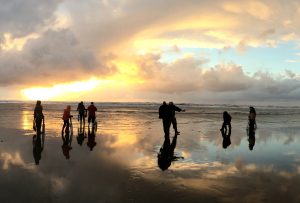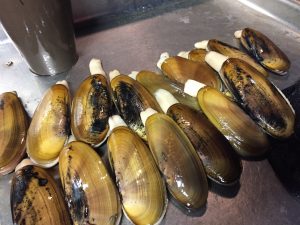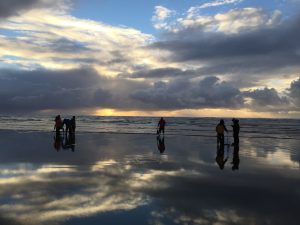Early coastal razor clam summer assessments show a drop in abundance especially at Long Beach Leave a reply
Coastal razor clam lovers will likely see a decline in clam populations for 2017-18 digging season.
State Fish and Wildlife biologists are in process of finalizing summer razor clam population assessments at Long Beach, Copalis, Mocrocks and Kalaloch. The exception is Twin Harbors that will undergo abundance surveys this coming week.
“Razor clam populations are down for most part on every beach, but in some cases it’s not too bad particularly at Mocrocks and Copalis,” said Dan Ayres, the head state Fish and Wildlife coastal shellfish manager. “It looks like more of an average year after we’ve been riding on this great big band wagon for a while now.”
“Our real puzzle is Long Beach adult razor clam population, which is down considerably,” Ayres said. “We didn’t do a lot of harvesting (last season) and also had a bonus (25) clam daily limit. I would’ve guessed that there should’ve been a lot more clams there due to that.”
Ayres and his survey crews plan to go back soon to Long Beach, which covers a broad stretch of beach-line from Columbia River mouth north to Leadbetter Point.
“We’ll look at a couple spots at Long Beach again, but won’t do assessments on whole beach,” Ayres said. “We’ll probably never know for sure what happened to the clams although we suspect the southern part of (Long Beach) was affected by freshwater run-off. When salinity levels are lower and young clams don’t like that. This is my best guess, but still doesn’t account for the central and northern beaches.”
Long Beach was supposed to be a shining star last season with oodles of razor clams, but elevated levels of marine toxins known as domoic acid — a natural marine toxin produced by certain types of marine algae that can be harmful or even fatal if consumed in sufficient quantities — had the beach closed virtually the entire season.
“We had hoped for a big banger of a season at Long Beach,” Ayres said. “During the brief (11) days of digging we saw good digging on northern end, but not so much on central section. It was a disappointment.”
Postseason estimates showed 77,778 digger trips on April 12-16 and April 26-May 1 (187,261 during 2015-16 season and 162,558 during 2014-15 season) at Long Beach yielded 1,555,113 clams (more than 2.61 million and 2.29 million clams respectively) for an average of 20.0 clams per person (14.0 and 14.1 respectively) clams per person. State fisheries bumped up the daily limit to first 25 clams dug person regardless of size or condition.
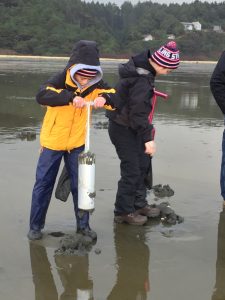
Tegan Yuasa (left) and Taylan Yuasa (right) try their luck for razor clams last winter at Copalis Beach.
With no clam surveys taken at Twin Harbors – one of more popular digging areas spanning from Grays Harbor south jetty at Westport south to Willapa Bay’s northern shore – until next week all we can do for now is look at 2016-17 season. Twin Harbors saw pockets of time where beaches were closed due to elevated levels of domoic acid although not nearly as dire as Long Beach.
Clam digging was open from Oct. 14-19, Nov. 17-19 and Nov. 26-28. Digging didn’t reopen until Feb. 7-12, Feb. 23-28 and March 7-13, and then in spring on April 5-9, April 12-16 and April 26-30.
In all Twin Harbors during 2016-17 season saw 62,893 diggers taking home 834,086 clams for a 13.3 clam per person average. The first 15 clams was a daily limit regardless of size or condition. Twin Harbors was completely shutdown in 2015-16 due to elevated levels of marine toxins.
To the north diggers should expect fairly good digging at Copalis Beach from Grays Harbor north jetty to Copalis River had a drop in razor clam populations, and Mocrocks Beach from Copalis River to southern boundary of Quinault Indian Reservation.
Exactly how much digging time at Copalis and Mocrocks depends on upcoming discussions with tribal fishery co-managers.
At Copalis from Oct. 14 through April 30 (33 total digging days), 82,108 digger trips (69,536 in 2015-16 season and 58,626 in 2014-15) saw a harvest of 1,040,193 clams (952,020 and 780,625 respectively) for 12.7 digger average (13.7 and 13.3 respectively).
At Mocrocks from Oct. 14 through April 29, 57,958 digger trips (70,747 in 2015-16 and 58,739 in 2014-15) had 686,628 (965,623 and 818,645 respectively) and harvested for 11.8 digger average (13.6 and 13.9 respectively).
The juvenile clam estimate at Kalaloch Beach on northern coast shows more than 100-million little guys sitting under the sand, but Ayres says many are very small pre-recruit clams tha won’t reach harvestable size for a while.
“We may have to wait a while to try to harvest them,” Ayres said. “We have around 190,000 adult-size clams which is less than half of what we had a year ago so it may be hard to make case until later on. This is lowest number of adult clams we have seen in past 25 years at Kalaloch. If you had density levels like this you’d have to search hard to find any (adult-size) clams.”
Hopes ran high for Kalaloch last season, which had been closed since 2011-12 season, and then saw a brief dig this past season on Jan. 8-9. That dig produced a paltry 1,410 clams for 637 diggers who averaged 2.2 clams per person.
During 2016-17, 68 digging days coast-wide produced 4,117,431 clams for 281,374 diggers trips compared to 4,665,743 clams with an effort of 327,545 during 2015-16 season.
So far this summer marine toxin levels for domoic acid remained under the 20 parts-per-million cutoff. Latest tests taken showed levels at 14.0 on July 12 at Long Beach; 8.0 on July 11 at Twin Harbors; 11.0 on July 25 at Copalis; and 11.0 on July 25 at Mocrocks.
Fall and winter razor clam digs occur during evening low tides while spring-time digs occur during morning low tides.
State Fish and Wildlife plans to have the public comment review period ready by early next month, and information will be posted at http://wdfw.wa.gov/fishing/shellfish/razorclams/.
“We’ll probably set some digging time during the first part of October where we have a series of good low tides, but everything is dependent on further marine toxin testing,” Ayres said.
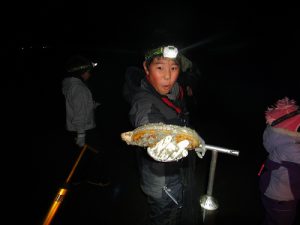
Ichiro Nakata of Mercer Island likes what he found in the sand during a night time dig at Copalis Beach.
Word on lost Puget Sound shellfish harvest opportunities
State Fish and Wildlife is looking for public opinion on a draft developed to make up for lost shellfish opportunities on Whidbey Island due to an oil spill from a boat that caught fire in 2012.
The area being looked at is Penn Cove, which was closed for shellfish for several weeks beginning in May of 2012.
“Calculating the value of these damages is a challenging process, but we think we have good data and rational to support our plan,” Don Noviello, with state Fish and Wildlife’s Oil Spill Team said in a news release.
If granted, the plan call for distribution of varying levels of oyster seeds at three beaches in the Penn Cove area over two seasons.
To view the plan, go to http://wdfw.wa.gov/conservation/habitat/oil_spill/damage.html. Submit comments via email through Sept. 5 at PennCoveNRDA@dfw.wa.gov.


